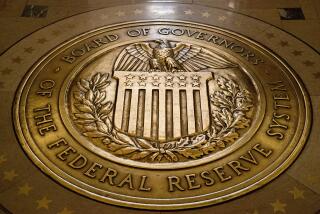Federal Reserve extends Operation Twist until end of 2012
WASHINGTON -- Acting amid increasing fears about the global economic slowdown, Federal Reserve policymakers announced Wednesday they were extending a program intended to lower long-term interest rates, but they opted not to take more forceful action.
Fed officials noted the recent poor economic data and said they were “prepared to take further action as appropriate to promote a stronger economic recovery and sustained improvement in labor market conditions” without fueling inflation. The central bank kept short-term interest rates at near zero percent.
But at the close of its two-day meeting, the Federal Open Market Committee did not take any bolder steps to boost the economy, such as a new round of stimulative bond buying. The stock market immediately dropped on the news.
Instead, the committee voted 11-1 to extend the program known as Operation Twist until the end of the year. The program, which began in September and was set to expire June 30, involves the Fed swapping short-term bonds for longer-term ones to bring down interest rates for mortgages and other long-term loans, triggering more borrowing and spending.
The Fed said it would exchange about $267 billion in short- and long-term Treasury securities over the last six months of the year.
The Fed took note of the economic slowdown, saying that employment growth has slowed in recent months, the housing market “remains depressed” and that household spending “appears to be rising at a somewhat slower pace than earlier in the year.”
The Fed has been under increasing pressure to take action to stimulate the economy in the face of slowing growth in the U.S. and mounting financial troubles in Europe.
Fed Chairman Ben S. Bernanke will hold his quarterly news conference later Wednesday and is expected to be pressed on the impact of the European debt crisis on the U.S. economy and what the Fed might do if growth continues to slow.
The U.S. economy grew at a tepid 1.9% annualized rate in the first three months of the year, down from 3% in the final quarter of 2011.
Investors were anticipating the Fed would do something Wednesday to respond to lagging growth, and some central bank officials have indicated recently they are prepared to do more. But the Fed, which has been taking extraordinary action to boost the economy since 2008, has limited options for action.
It declined to launch a new round of bond-buying, known as quantitative easing; the previous two rounds have dramatically expanded the Fed balance sheet and sparked sharp criticism from many Republicans. The Fed’s action Wednesday came amid indications that the Bank of England was edging closer toward expanding its quantitative easing program.
Bernanke told Congress on June 6 that the economy was continuing to grow moderately despite the sharp drop-off in job creation in recent months, highlighted by a paltry 69,000 new jobs added in May. Fed policymakers would have to decide at this month’s meeting if that growth was enough “to achieve continued progress in the labor market,” he said.
RELATED:
Stocks edge lower ahead of Fed announcement
G-20 summit ends with Europe still hanging over Obama
Bernanke: Despite employment slowdown, economy growing moderately
More to Read
Inside the business of entertainment
The Wide Shot brings you news, analysis and insights on everything from streaming wars to production — and what it all means for the future.
You may occasionally receive promotional content from the Los Angeles Times.











